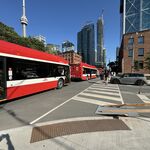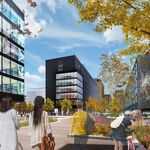Then, they need large trains. And that will limit the frequency. I can see them achieving 10-min, or perhaps 7.5 min in order to blend better with the 15-min GO RER network. But 5-min is unlikely.
From what I can tell, Weston sub can handle 5 minute frequencies after its 0.62 mile resignalling. Potential interferences with UPX would need to be worked out though, unless UPX is merged with SmartTrack somehow by then. Then it really is only Union station as well as Unionville that's the bottleneck.
They don't need large trains 24/7 at 5 minute, except for peak. It would not be economically prudent anyway. You can run shorter 150 meter trains, and there are bi-level EMUs available if the capacity is needed.
I see a potential bottleneck interspersing diesel trains (Kitchener, Unionville).
A) The double-tracking project to Markham limits diesel+electric interspersing, but if they electrify all the way to Stoufville, then they can simply short-turn the frequent trains, running the rest of the trains hourly to Stoufville. Basically, in other words, SmartTrack goes all the way to Stoufville hourly (with the rest of the trains short-turning)
Solution: Full electrification of Stoufville
B) Then if USRC is resignalled and using higher speed crossovers (up to 25mph) for a bit faster approach right before the edge of Union platforms, I think 5-minute frequencies is achievable with short-dwells and eliminating timetabled operation (just push the trains through as quickly as possible, allowing trains to leave a bit early/late to keep the next train closer to approximately 5 minute frequencies).
Solution: USRC resignalling, and possibly higher speed crossovers. Run subway-style dwelling at Union.
C) High platform stations, as a possibility of the high cost of SmartTrack. High platforms for specific tracks at Union, for faster level boarding -- this might explain part of the high cost of SmartTrack enhancements to GO RER. All new stations would be high platform (since more than half of "SmartTrack" route is new stations) with retrofitting ALL stations on Stoufville to high platforms (since low floor service could in theory be discontinued on Stoufville). If Kitchener diesel trains go express, then almost ALL stations to Brampton could become high platform only.
Solution: Eliminate diesel low floor service from almost all stations on the SmartTrack section of GO RER. This is done by electrifying all of Stoufville line (as mentioned above), as well as making Kitchener diesel hourly trains go express to the end of the SmartTrack route. Then we can convert almost all existing stations on the SmartTrack route to high platforms, and only build high platforms for the new stations. The classic Bombardier BiLevels could cease to stop at most stations on the SmartTrack route, as it becomes no longer necessary for them to do so.
D) Also necessary, is, you'd merge 4 routes into 2 (like LSW-LSE, the Kitchener-Stoufville becomes 1 route).
Solution: Make Bramalea-Stoufville into one through electric route. (with the exception of hourly all-the-way-to-Kitchener diesel trains) Short-turn where necessary, and that a single electric trainset is utilized for ALL services on Stoufville line, including hourly services all the way to the end of the Stoufville line.
People are asking why SmartTrack enhancements to GO RER costs so much, and I always viewed this as potentially because of retrofitting for high-platform operation for quick subway-style boarding with short-dwells and untimetabled operation (at least at peak), improved safety (including smoother snagless EMU trains).
Several lines in Europe/Japan can handle 3-minute headways with high speed trains, so some of the SmartTrack spending could be to make the corridor capable of 5-minute headways.






